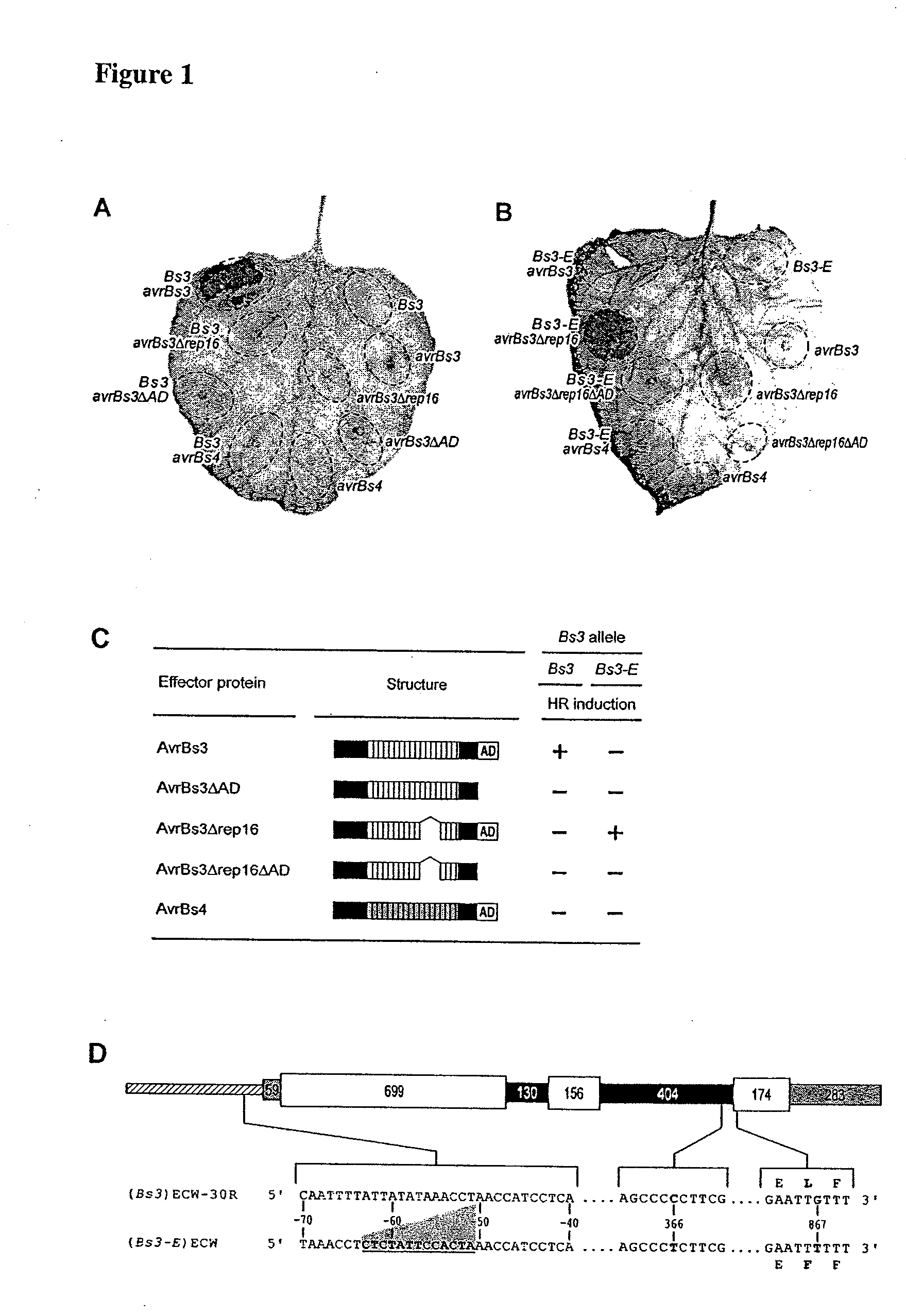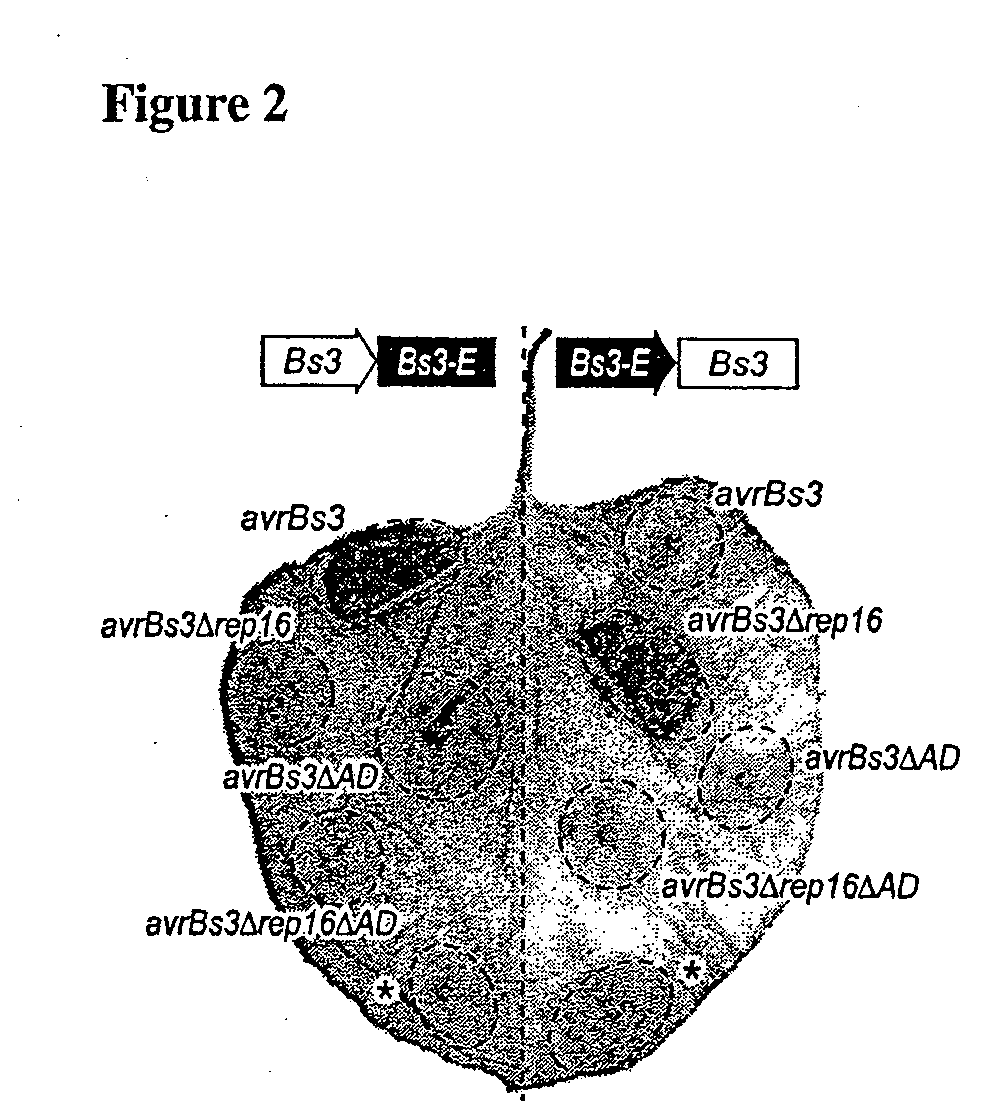Bs3 resistance gene and methods of use
a resistance gene and resistance technology, applied in the field of bs3 resistance gene and methods of use, can solve the problems of vesicatoria /i>(xcv), can be devastating to the commercial production of these crops, and achieve the effect of increasing the resistance of a plant pathogen
- Summary
- Abstract
- Description
- Claims
- Application Information
AI Technical Summary
Benefits of technology
Problems solved by technology
Method used
Image
Examples
example 1
Isolation of the Wild-Type (Bs3) and Bs3-E Alleles of the Pepper Bs3 Gene
[0146]The Bs3 gene of pepper was isolated by from previously identified bacterial artificial chromosome (BAC) clones derived from the pepper (Capsicum annuum) cultivar Early Californian Wonder 30R (ECW-30R) that cover the Bs3 gene (Jordan et al. (2006) Theor. Appl. Genet. 113:895).
Materials and Methods
Plant Material and Infiltrations
[0147]Pepper (Capsicum annuum) plants of cultivar Early California Wonder (ECW) and the near-isogenic line ECW-30R containing the resistance gene Bs3 and N. benthamiana plants were grown in the greenhouse under standard conditions (day and night temperatures of 24 and 19° C., respectively), with 16 h of light and 60 to 40% humidity. Pepper cultivar ECW and the near-isogenic line ECW-30R seeds were provided by R. E. Stall (University of Florida, Gainesville). Six-week-old pepper plants were inoculated with Xanthomonas with 5×108 colony forming units / ml with a needle-less syringe. For...
example 2
Construction and Analysis of Chimeric Bs3 / Bs3-E and Bs3-E / Bs3 Genes
[0154]The Bs3 promoter was fused to the Bs3-E coding sequence and vice versa and co-transformed N. benthamiana with these chimeras in combination with avrBs3, avrBs3Δrep16 or the corresponding AD mutant derivatives.
Methods
Generation of Chimeric Constructs
[0155]Chimerical gene constructs were generated by splicing using overlap extension (SOE) PCR (Horton et al. (1989) Gene 77:61). Bs3 and Bs3-E promoters were amplified from genomic DNA of ECW and ECW-30R pepper cultivars, respectively, with the Phusion-polymerase and A1-fwd-PR (CTACGGAATAGCAGCATTAAGGCACATCAG; SEQ ID NO: 18) and B5-rev-PR (CATACGGAACACTGTATTGCTTAAGG; SEQ ID NO: 19) primers. The coding regions were amplified with final-entry-01-fwd (ATGATGAATCAGAATTGCTTTAATTCTTGTTC; SEQ ID NO: 20) and final-entry-02-rev (CATTTGTTCTTTCCAAATTTTGGCAATATC; SEQ ID NO: 21) primers. PCR-products of the coding and promoter region were mixed in a 1:1 ratio and PCR amplified usi...
example 3
Analysis of the Expression the Bs3 Gene in Pepper Leaves Inoculated with Virulent and Avirulent Xcv Strains
Methods
RT-PCR Analysis of Xcv Infected Leaves
[0157]The abaxial leaf surface of ECW and ECW-30R pepper plants was inoculated with Xcv strain 85-10 (OD600=0.4) with a blunt syringe. Inoculations were carried out with isogenic Xcv strains expressing avrBs3 (pDS300F) (Van den Ackerveken et al. (1996) Cell 87:1307), avrBs3ΔAD (pDSF341) (Szurek et al. (2001) Plant J. 26:523), avrBs4 (pDSF200) (Schornack et al. (2004) Plant J. 37:46), avrBs3Δrep16 (pDSF316) (Herbers et al. (1992) Nature 356:172) or avrBs3Δrep16ΔAD (pDSF317). Four leaf discs (5-mm diameter) were harvested 24 hours after inoculation and were used for each RNA-extraction using the Qiagen RNeasy Plant Miniprep kit (Qiagen, Hilden, Germany). RNA concentrations were determined with a ND-1000 spectrophotometer (Nanoprop Technologies, Rockland, Del., USA) and adjusted prior to cDNA synthesis. cDNA was synthesized by reverse t...
PUM
| Property | Measurement | Unit |
|---|---|---|
| temperature | aaaaa | aaaaa |
| temperature | aaaaa | aaaaa |
| pH | aaaaa | aaaaa |
Abstract
Description
Claims
Application Information
 Login to View More
Login to View More - R&D
- Intellectual Property
- Life Sciences
- Materials
- Tech Scout
- Unparalleled Data Quality
- Higher Quality Content
- 60% Fewer Hallucinations
Browse by: Latest US Patents, China's latest patents, Technical Efficacy Thesaurus, Application Domain, Technology Topic, Popular Technical Reports.
© 2025 PatSnap. All rights reserved.Legal|Privacy policy|Modern Slavery Act Transparency Statement|Sitemap|About US| Contact US: help@patsnap.com



